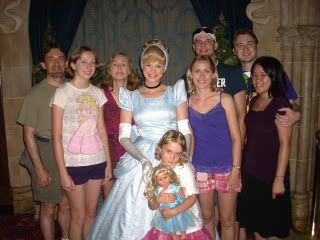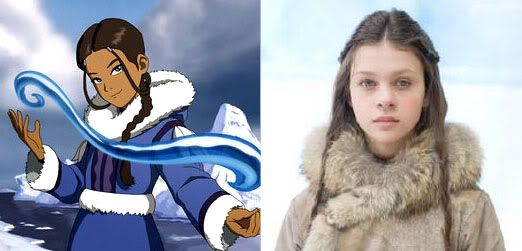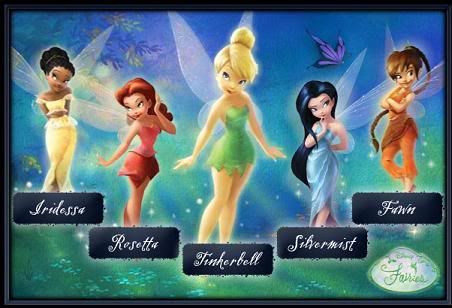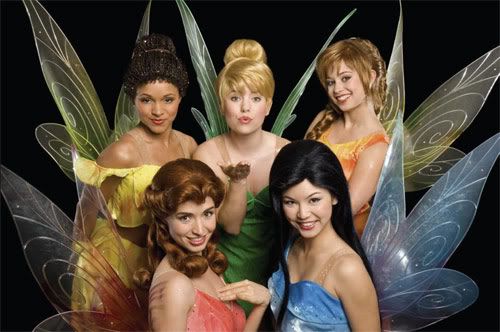Tinkerbell's Amazing Ethnic Friends
There was a lovely little four year old girl with her mom on the bus, sitting across from me today. Her mom was reading the Entertainment section of the paper. She pointed at an ad and asked, "Who is this?"
The little girl pointed at the advertisement, too and said, "The AVATAR!" Then she turned to her mom and said, "Is that the REAL Avatar?"
I guess it didn't hit me until today that when kids see animated characters come to life, then that version of the animated character is the "real" version of the character. So, for example, when I went with Ken's family to meet Cinderella at Disney World, to his five year old niece, it was like meeting the real Cinderella. The one in the flesh.

So if when animated characters are made flesh, they become real, then what does it mean when an animated character with indigenous ethnicity and an anorak--one of the very few animated female heroines to ever be depicted with dark skin--is transferred into the real world, but looks and is portrayed by someone who is white?

To an adult it could mean any number of things, I suppose, ranging from "racism" to "cultural appropriation" to "nothing to get your panties in a twist over."
But I want to know what it means to a kid. Because children notice skin color. And they quickly notice, from observing how adults treat one another, that skin color clearly matters.
To the point where when you tell an African American kindergartener a story where the hero has darker skin and the villain has lighter skin, the child will misremember the story so that the hero had light skin and the villain had dark skin. The child will change the story to fit the more widely accepted paradigm.
To the point where, when you show kids pictures of cartoon characters with light skin or dark skin, the kids prefer the characters with light skin. Without fail. They label the dark skinned dolls and cartoon characters as nasty and ugly.
Watch this. You will feel sad and awkward.
So what is a child to think when a beloved character becomes flesh and blood--and looks different?
I know what detractors of Racebending.com, even M. Night Shymalan himself would say. Counter to repeated claims by people who worked on the series, they would say that the characters of animated series did not have an ethnicity, that they are ambiguous. They would ignore that society and that Hollywood is not-so ambiguous when it comes to preferring certain races and certain genders.
While I'm skeptical of the claim that 'fictional characters do not have ethnicities' (I raise you one Jar Jar Binks), real people most certainly have ethnicities. When an animated character is translated into 'real' by an actor, and it's always actors from the same community...that says something.
I get emails every day that start off with, "The [Avatar characters] are not Asian or Inuit; they are from a fantasy world..." leading to the inevitable conclusion that I am the "real racist" for labeling them with ethnicities or for having the expectation of cultural representation in the media people consume.
People like to use Lord of the Rings as an analogue to Avatar: The Last Airbender. Middle Earth is an analogue to European fantasy; Four Nations to Wuxia fantasy. Gandalf the White is white. But let's look at fairies. Namely, Disney's Fairies. Another franchise kids like, that Five Token Bands it's main characters.
The Fairies are from a fantasy world: Neverland. They're not even human. So, do they have ethnicities?

"Disney Fairies builds upon the enormous popularity of Tinker Bell and introduces girls to her secret, magical world and a new circle of enchanting fairy friends - each with an incredibly diverse talent, personality and look." (Real subtle, Disney.)
Take uh, "Iridessa," for example. Is she an "African American"? A fairy? Both? And that one with dark hair, is she Asian? Asian American? Asian Fairy-an? What about Fawn, the fairy that Disney flat out markets as it's new Hispanic character? So they're saying that fairies can be Hispanic, now? (Yes!)
These fairies don't have accents or dress in kimonos or speak in ebonics or dance the salsa so, like, how did Disney know to cast them this way when they made them "real"?

As an adult there's a certain level of cynicism towards Tinkerbell and her multiethnic friends. Tokenism? The fact that Tinkerbell is still central to all of this? Disney is catering to a demographic of American children, one that is made up of 45% people of color, you don't say?
But I imagine for a kid of color, say, a girl who can't even find a Barbie doll that looks like her at her average Toys R Us--Disney put in a ginger fairy, too!-- it must be fun to get to find a doll who looks like you for once. I know that it was a little heartwarming for me to see Ken's niece choose to play with an Asian fairy doll (instead of just going for Tinkerbell, who she more closely resembles) at Disney World. She was experiencing something I never experienced growing up--playing with a doll with Asian features. She was affirming, in a way, that kids can learn to relate with people who look different from them.
But they're fairies and fantasy and therefore raceless, so if Disney had cast the "real" flesh and blood models with all white actresses, it would be "reverse racist" to complain, right?
The little girl pointed at the advertisement, too and said, "The AVATAR!" Then she turned to her mom and said, "Is that the REAL Avatar?"
I guess it didn't hit me until today that when kids see animated characters come to life, then that version of the animated character is the "real" version of the character. So, for example, when I went with Ken's family to meet Cinderella at Disney World, to his five year old niece, it was like meeting the real Cinderella. The one in the flesh.

So if when animated characters are made flesh, they become real, then what does it mean when an animated character with indigenous ethnicity and an anorak--one of the very few animated female heroines to ever be depicted with dark skin--is transferred into the real world, but looks and is portrayed by someone who is white?

To an adult it could mean any number of things, I suppose, ranging from "racism" to "cultural appropriation" to "nothing to get your panties in a twist over."
But I want to know what it means to a kid. Because children notice skin color. And they quickly notice, from observing how adults treat one another, that skin color clearly matters.
To the point where when you tell an African American kindergartener a story where the hero has darker skin and the villain has lighter skin, the child will misremember the story so that the hero had light skin and the villain had dark skin. The child will change the story to fit the more widely accepted paradigm.
To the point where, when you show kids pictures of cartoon characters with light skin or dark skin, the kids prefer the characters with light skin. Without fail. They label the dark skinned dolls and cartoon characters as nasty and ugly.
Watch this. You will feel sad and awkward.
So what is a child to think when a beloved character becomes flesh and blood--and looks different?
I know what detractors of Racebending.com, even M. Night Shymalan himself would say. Counter to repeated claims by people who worked on the series, they would say that the characters of animated series did not have an ethnicity, that they are ambiguous. They would ignore that society and that Hollywood is not-so ambiguous when it comes to preferring certain races and certain genders.
While I'm skeptical of the claim that 'fictional characters do not have ethnicities' (I raise you one Jar Jar Binks), real people most certainly have ethnicities. When an animated character is translated into 'real' by an actor, and it's always actors from the same community...that says something.
I get emails every day that start off with, "The [Avatar characters] are not Asian or Inuit; they are from a fantasy world..." leading to the inevitable conclusion that I am the "real racist" for labeling them with ethnicities or for having the expectation of cultural representation in the media people consume.
People like to use Lord of the Rings as an analogue to Avatar: The Last Airbender. Middle Earth is an analogue to European fantasy; Four Nations to Wuxia fantasy. Gandalf the White is white. But let's look at fairies. Namely, Disney's Fairies. Another franchise kids like, that Five Token Bands it's main characters.
The Fairies are from a fantasy world: Neverland. They're not even human. So, do they have ethnicities?

"Disney Fairies builds upon the enormous popularity of Tinker Bell and introduces girls to her secret, magical world and a new circle of enchanting fairy friends - each with an incredibly diverse talent, personality and look." (Real subtle, Disney.)
Take uh, "Iridessa," for example. Is she an "African American"? A fairy? Both? And that one with dark hair, is she Asian? Asian American? Asian Fairy-an? What about Fawn, the fairy that Disney flat out markets as it's new Hispanic character? So they're saying that fairies can be Hispanic, now? (Yes!)
These fairies don't have accents or dress in kimonos or speak in ebonics or dance the salsa so, like, how did Disney know to cast them this way when they made them "real"?

As an adult there's a certain level of cynicism towards Tinkerbell and her multiethnic friends. Tokenism? The fact that Tinkerbell is still central to all of this? Disney is catering to a demographic of American children, one that is made up of 45% people of color, you don't say?
But I imagine for a kid of color, say, a girl who can't even find a Barbie doll that looks like her at her average Toys R Us--Disney put in a ginger fairy, too!-- it must be fun to get to find a doll who looks like you for once. I know that it was a little heartwarming for me to see Ken's niece choose to play with an Asian fairy doll (instead of just going for Tinkerbell, who she more closely resembles) at Disney World. She was experiencing something I never experienced growing up--playing with a doll with Asian features. She was affirming, in a way, that kids can learn to relate with people who look different from them.
But they're fairies and fantasy and therefore raceless, so if Disney had cast the "real" flesh and blood models with all white actresses, it would be "reverse racist" to complain, right?